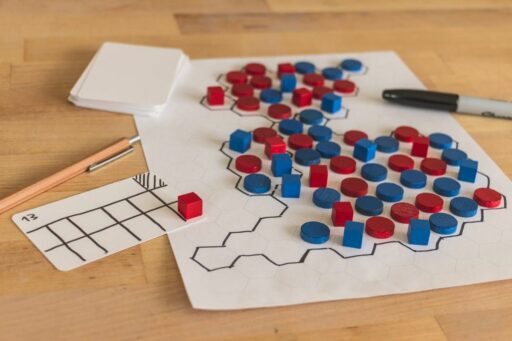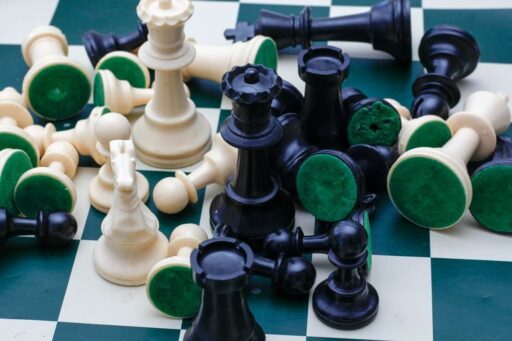Have you ever dreamed of designing your own board game, bringing your unique vision to life, and sharing it with friends and family? Crafting a board game from scratch can be a thrilling and rewarding endeavor. This ultimate guide will walk you through the process of creating your own board game template, from conceptualizing your game’s theme to marketing the finished product. With the help of Apostrophe Games’ DIY kit and other resources, you’ll have everything you need to transform your ideas into a playable reality.
Key Takeaways
- Start by conceptualizing your board game with a captivating theme and clear objectives to ensure a focused design process.
- Design game mechanics that are engaging, balancing rules, strategies, chance, and skill to provide a fun and challenging experience.
- Craft game components that are visually appealing and functional, using tools like blank boards and cards to create a professional-looking game.
- Prototype and playtest your game extensively, gathering feedback to refine gameplay and mechanics for the best player experience.
- Explore production options for publishing your game and create a compelling marketing strategy to reach your target audience.
Conceptualizing Your Board Game

Choosing a Theme and Story
The foundation of any board game is its theme and story, which provide context and direction for the gameplay. Choosing the right theme is crucial as it not only captivates players but also guides the subsequent design decisions. When selecting a theme, consider the world you want to create; whether it’s a realm of magic, a historical setting, or a futuristic landscape, it should be immersive and coherent.
To start, brainstorm characters, creatures, and elements that fit within your chosen world. Use these to inform the game’s name and mechanics, ensuring they align with the theme for a cohesive experience. For example, a game involving spells might feature wizards and magical beasts, each with unique abilities that affect gameplay.
The Mechanics of Theme – by Justin Gary, suggests that creating a game presents a unique challenge in deciding what elements are essential and what can be omitted regarding the theme.
Remember, the theme is not just a backdrop but an integral part of the game that can enhance player engagement. It’s the narrative that drives the search for treasure in a pirate game or the strategic battles in a war-themed game. The story you weave through the theme will shape the players’ journey and the memories they take away from the game.
Defining the Objectives
Once you have chosen a theme for your board game, the next crucial step is to define clear objectives. Objectives are the backbone of your game’s structure and provide players with a goal to strive for. They should be intrinsically linked to the theme and story to create a cohesive experience.
To ensure that your objectives are well-defined, consider the following points:
- The end goal of the game: What is the ultimate achievement for players?
- The challenges they must overcome: What obstacles will players face?
- The actions players can take: What moves or decisions can players make?
- The conditions for winning or losing: What determines the game’s outcome?
It’s essential to articulate the objectives in a way that is easy to understand yet challenging to achieve. This balance keeps players engaged and motivated throughout the game.
Remember, the primary function of any rule book is to explain the goals and objectives of the game clearly. Players should be able to grasp what they are working towards from the outset, which will guide their strategies and decision-making as they navigate through the game.
Balancing Complexity and Fun
When creating your own board game, one of the most crucial aspects to consider is the balance between complexity and enjoyment. A well-balanced game ensures that players are engaged without feeling overwhelmed. It’s essential to create rules and character abilities that provide an even playing field, avoiding scenarios where certain characters dominate every game.
Balancing a game requires careful adjustment of the mechanics to ensure that each player has a fair chance of winning, while still facing challenges that are fun to overcome.
Consider the following points when balancing your game:
- Include abilities or cards that can turn the tide of the game, adding an element of surprise and strategy.
- Implement rules that prevent a player from winning too easily, maintaining tension and excitement until the end.
- Ensure that the game pace is brisk to keep players engaged, aiming for impactful turns that drive the game forward.
Remember, the goal is to craft an experience that is both challenging and enjoyable, where strategy and luck play their roles in harmony.
Designing the Game Mechanics

Creating Rules and Instructions
The foundation of any board game is its rules and instructions, which guide players through the gameplay experience. Crafting clear and concise rules is essential to ensure that players understand how to play and what they can and cannot do. Start by outlining the basic actions available to players, such as moving pieces, drawing cards, or scoring points.
- Define the starting conditions, such as the initial setup of the game board and pieces.
- Detail the turn sequence and what actions can be taken on a player’s turn.
- Establish any special rules for player interaction, like trading or battling.
- Clarify the win conditions and how the game ends.
Remember, the goal is to create a rulebook that is easy to navigate and understand, avoiding ambiguity that could lead to confusion during play.
As you develop your rules, consider the flow of the game and how each rule contributes to the overall experience. It’s important to strike a balance between providing enough structure to guide gameplay and allowing for creative strategies that keep players engaged. Once you have a draft of your rules, it’s crucial to test them thoroughly to ensure they work as intended and are enjoyable for players.
Developing Strategies and Challenges
When creating a board game, developing strategies and challenges is crucial for engaging gameplay. Players should be able to use their understanding of the game mechanics to advance in the game and improve their chances of winning. This involves a mix of logical reasoning, anticipation of opponents’ moves, and the application of both pure and mixed strategies.
Effective strategies include understanding the game mechanics, using logical reasoning to anticipate moves, and mastering both pure and mixed strategies.
To ensure that your game offers a variety of strategic options, consider the following points:
- Introduce elements that allow for strategic depth, such as cards that enable players to influence the game in unexpected ways.
- Encourage player interaction by implementing rules that require engagement, like mandatory attacks each round.
- Balance the game by providing multiple paths to victory, preventing any one strategy from dominating.
Remember, the goal is to create a game that is both challenging and enjoyable, where players feel their decisions have a meaningful impact on the outcome.
Incorporating Chance and Skill Elements
A well-designed board game strikes a delicate balance between chance and skill, ensuring that each playthrough is unique while still rewarding strategic thinking. Incorporating elements of chance can level the playing field, allowing less experienced players to compete with veterans. However, it’s crucial to avoid scenarios where the game feels too random or entirely skill-based.
To achieve this equilibrium, consider the impact of each chance element on the game’s overall flow. A random card draw or dice roll should offer opportunities for players to make meaningful decisions, rather than dictating the game’s outcome.
Skill elements, on the other hand, should encourage players to develop strategies and adapt to changing situations. For example, a player might need to decide whether to save resources for a potential future gain or spend them immediately for a smaller but guaranteed advantage. Below is a list of considerations when balancing chance and skill:
- Ensure that no single strategy dominates the game.
- Provide multiple paths to victory to accommodate different play styles.
- Introduce mechanics that can mitigate bad luck, such as ‘second chance’ cards.
- Design challenges that require players to think ahead and plan their moves.
Remember, the goal is to create a game that is engaging and competitive for all players, regardless of their initial position or luck of the draw.
Crafting the Game Components

Designing the Game Board and Pieces
The design of the game board and pieces is a critical step in bringing your board game to life. The aesthetics and functionality of these components are essential in providing an immersive experience for players. Start by sketching out the layout of the board, considering the flow of gameplay and the placement of key areas. For the pieces, think about how they represent the players or factions within the game’s universe.
When selecting materials for your board and pieces, durability and cost are important factors. Here’s a quick reference for common materials used in board game production:
- Cardboard: Affordable and versatile, suitable for both boards and pieces.
- Wood: Durable and gives a premium feel, often used for high-quality pieces.
- Plastic: Offers a wide range of colors and shapes, commonly used for intricate pieces.
Remember, the components should not only be visually appealing but also practical. They must withstand repeated use and be easy to handle during play.
Incorporating personal touches, such as adding text strings to pieces or designing a unique box, can set your game apart. Be mindful of the production process, as customizations like numbering pieces from 0 to 999 may require specific manufacturing capabilities. Ultimately, your goal is to create components that resonate with your theme and story, enhancing the overall gaming experience.
Customizing Cards and Tokens
Customizing cards and tokens is a creative process that adds personality and depth to your board game. Use colors and symbols to differentiate card types, making it easier for players to recognize and organize them during gameplay. For instance, assigning a unique color to character cards and another to item cards can significantly enhance the player’s experience.
When designing the artwork for your cards, invest time in creating distinctive and thematic designs. The art is not just a visual treat but also an integral part of the game’s storytelling. Consider the back of the cards as well; it’s an opportunity to extend the game’s theme. A medieval game, for example, might feature a wood or leather texture on the card backs, or perhaps a logo or symbol that represents the game’s core concept.
Custom tokens can be made durable and visually appealing with a little ingenuity. For example, metal washers and laminated sticker paper can be used to create tokens that withstand frequent handling and add a professional touch to your game.
Remember, the goal is to create components that are not only functional but also contribute to the immersive experience of your board game. Feel free to share more ideas and your own creative approaches to card and token customization in the community forums.
Selecting and Applying Artwork
Once you’ve designed the components of your board game, the next step is to bring them to life with artwork. Selecting and applying artwork is crucial, as it not only enhances the visual appeal but also aids in storytelling and player immersion. Start by sketching out your ideas on paper or cardstock, creating a central box for the main art and additional spaces for titles and descriptions.
- Draw your main characters, items, and creatures within the art box.
- Use vibrant colors and additional artwork to make each card stand out.
- Ensure the title is clear and complements the overall design.
After your initial sketches, refine your designs to give your game a unique and cohesive look. Remember, the art of the cards can really make your game look good, so dedicate time to perfecting this aspect. Once satisfied, cut out the cards and consider drawing a back design for a professional finish.
Making multiple cards at once can streamline the process. Lay out a row of templates on a sheet and fill them out sequentially to maintain consistency and save time.
Prototyping and Playtesting

Building Your First Prototype
Once you’ve laid the groundwork for your board game, it’s time to bring your vision to life with a prototype. Start by gathering materials that can represent your game components, such as cardstock for cards, tokens, and a makeshift board. Don’t worry about aesthetics at this stage; focus on functionality.
Prototyping is about testing the playability of your game, not its final look.
Create a simple version of your game that you can use to test the mechanics. This might include a basic game board drawn on poster board and simple cards made from index cards. Remember, the goal is to iterate quickly and identify any issues with the game flow or rules.
Here’s a checklist to guide you through the prototyping process:
- Sketch out the game board layout
- Create a rough set of game cards
- Assemble any necessary tokens or pieces
- Write down basic rules and instructions
Once your prototype is ready, you can move on to playtesting, where you’ll gather valuable feedback from players. This feedback is crucial for refining your game and taking it to the next level.
Gathering Feedback from Playtesters
Once your board game prototype is in the hands of playtesters, it’s crucial to gather constructive feedback that will guide the refinement process. Encourage playtesters to be candid, focusing on both the strengths and weaknesses of the game. Create an environment where they feel comfortable sharing their honest opinions.
- Set a clear objective for each playtesting session.
- Balance the types of feedback you seek, from gameplay mechanics to the fun factor.
- Educate your playtesters on the kind of feedback that’s most helpful.
Remember, not all feedback will be actionable, but it’s important to listen and consider every piece of advice. Look for patterns in the feedback that suggest where the game could be improved.
After collecting feedback, organize it into categories such as ‘Game Mechanics’, ‘Design’, and ‘Player Experience’. This will help you identify which areas need the most attention and streamline the revision process.
Refining the Game Based on Insights
Once you’ve gathered feedback from playtesters, it’s time to refine your game. Identify common themes in the feedback and prioritize changes that will have the most significant impact on gameplay. Consider both the mechanics and the enjoyment factor when making adjustments.
- Review the rules for clarity and balance.
- Adjust the game mechanics to improve flow and engagement.
- Update or add new components based on playtester suggestions.
- Fine-tune strategies and challenges to ensure they are fair and fun.
Remember, the goal is to create a game that is both challenging and enjoyable. Small tweaks can often lead to significant improvements in the player experience.
After implementing changes, it’s crucial to playtest again. This iterative process helps you hone in on the perfect balance between strategy and chance, complexity and fun. Keep track of the changes made and the outcomes of each playtesting session to guide further refinements.
Publishing and Marketing Your Game

Exploring Production Options
Once your board game has been thoroughly playtested and refined, it’s time to consider how to bring it to market. Exploring production options is a critical step that can significantly impact the cost, quality, and scalability of your game. There are two main routes you can take: self-publishing or partnering with a game publisher.
Self-publishing gives you full control over the production process, from selecting manufacturers to choosing distribution channels. However, it requires a significant investment of time and resources. Here’s a simplified list of steps you might follow:
- Research and select a manufacturer
- Determine the print run size
- Calculate the cost per unit
- Handle logistics for distribution
On the other hand, pitching to a game publisher can alleviate much of the burden. Publishers often have established relationships with manufacturers and distributors, which can streamline the process. However, this option might mean less creative control and a smaller share of the profits.
It’s essential to weigh the pros and cons of each production route carefully to decide which aligns best with your goals and resources.
Remember, the choice between self-publishing and seeking a publisher is not just about the practicalities of production; it’s also about your comfort level with various aspects of the business side of board games. For instance, pitching to publishers is much less time intensive and is an easier option for the lone designer, but it requires a certain comfort with selling your idea.
Creating an Engaging Product Description
Crafting an engaging product description is crucial for capturing the interest of potential customers. Your description should highlight the unique aspects of your game, making it irresistible to your target audience. Start by outlining the key components included in the box, such as cards and dice, and emphasize the quality and versatility of these items.
- Include a brief overview of the game’s theme and objectives.
- Mention the materials used and their durability.
- Share testimonials that underscore the game’s appeal and ease of customization.
Remember, the product description is not just about what’s in the box; it’s about the experiences players will have and the memories they will create.
Avoid technical jargon and focus on the emotions and excitement the game can provide. If there are any common concerns or points of praise from customer feedback, address them succinctly. This approach helps build trust and sets realistic expectations for your game.
Promoting Your Game to the Right Audience
Once your board game is ready to hit the shelves, the next crucial step is to ensure it reaches the right audience. Effective promotion is not just about making noise; it’s about making the right noise in the right places. Start by identifying your target demographic and understanding where they spend their time, be it on social media, board game forums, or community events.
To maximize your reach, consider the following strategies:
- Engage with online communities, such as Board Game Arena, to create buzz and gather support.
- Utilize social media platforms to share engaging content and updates about your game.
- Collaborate with influencers and content creators who can showcase your game to their followers.
- Offer translations of your game to cater to a global audience and increase accessibility.
Remember, the goal is to create a connection with potential players and make them excited about your game. Tailor your promotional efforts to align with your game’s theme and story, ensuring a consistent and compelling message.
It’s also beneficial to analyze competitor’s video ads and identify market trends to refine your marketing approach. Keep an eye on the success of similar games and learn from their strategies to enhance your own promotional activities.
Conclusion
Creating your own board game template is an exciting journey into game design, offering a personalized touch to your game nights. With the resources and tips provided in this guide, you’re now equipped to transform your creative ideas into a tangible board game. Whether you choose to use a DIY kit from Apostrophe Games or craft each element by hand, the possibilities are endless. Remember, the key to a successful board game lies in balancing simplicity with strategic depth, ensuring replayability and enjoyment for all players. Embrace the process, learn from each iteration, and most importantly, have fun bringing your vision to life. Happy gaming!
Frequently Asked Questions
What are the essential components needed to create a board game?
The essential components for creating a board game include a game board, playing cards, dice, player tokens, and a game spinner. You can purchase a DIY kit with blank materials to customize your own game.
How can I decide on a theme for my board game?
To decide on a theme, consider your interests or popular genres. Look for inspiration in books, movies, history, or mythology. Make sure the theme is engaging and can be expanded into a compelling story for your game.
What’s the best way to balance complexity and fun in a board game?
Balancing complexity and fun involves creating rules that are easy to understand but allow for strategic depth. Playtesting is crucial to find the right balance where the game is challenging without being overly complicated.
How important is artwork in the design of a board game?
Artwork is extremely important as it enhances the visual appeal and helps in storytelling. It can also assist with gameplay by making components easier to distinguish and the game more immersive.
What should I focus on during the playtesting phase?
During playtesting, focus on gathering feedback about the game’s mechanics, balance, and fun factor. Observe player interactions and ask for suggestions to refine the game and improve the overall experience.
Can I sell my board game on platforms like Amazon?
Yes, you can sell your board game on platforms like Amazon. Make sure to create a compelling product description and utilize marketing strategies to reach the right audience and increase visibility.





